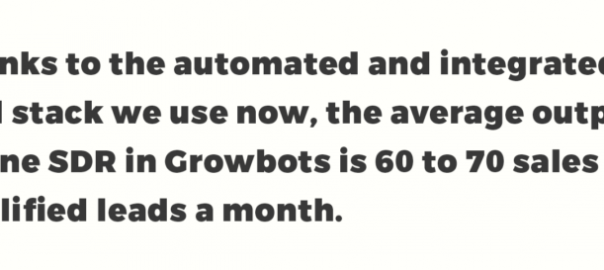What do you do when a new time-saving tool ends up taking up more time than it saves? Most of us have been diligently adding every shiny new widget and doohickey to our sales stack that will streamline a process here or shave an hour off prospecting there. After all, the goal is to make it as easy and quick as possible for our sales team to do their job. To achieve this goal, a part of our budgets is generally allocated to the purchase of new time-saving sales solutions.
While some time-saving solutions provide great ROI, plenty of them simply add a layer of complexity to your sales stack and actually waste your sales team’s time instead of saving it. This is because not all of the tools integrate with each other seamlessly. A custom development often needs to be done to integrate two solutions, so this step is simply skipped by the software house. Instead of streamlining your sales stack, these half measures simply create more inefficiencies that you have to deal with.
We all want our sales to be able to focus on customers and not admin. To do this, we need to keep our sales stack in line, helping us make more sales, which leaves us with a question.
How can we make sure that the tools in our sales stack are adding value, not taking it away?
I am sure it comes as no surprise when I say that we have wrestled with this issue at Growbots. And I would be lying if I said that we have completely left the problem of a clunky sales stack in the past. We have indeed needed to do our best to make our sales stack run as smoothly as possible. You see, our sales organization grew from 3 to almost 20 people in about a year. This meant that we had to deal with the shortcomings of an expanding sales stack and we had to deal with them quickly.
The consequence of not doing anything would have been that our sales stack would get so convoluted, we would have spent more time training people on how to use new tools than on getting them selling. Instead of contributing to our bottom line from the get go, our new hires would be mired in figuring out how to use the tools we had given them. So how did it get this way?

Clunky sales stacks come from the organic evolution of your sales process.
Think about when your company started its sales team. You didn’t have many resources or customers so you used what was affordable for you. This means that you probably relied on an Excel or Google spreadsheet where you add notes about your first meetings with your potential customers. Essentially it acted as a makeshift CRM where you recorded all of your sales interactions.
Of course, this kind of solution is temporary at best. Sooner or later you decide to introduce to your sales stack tools that make your sales process simpler and faster. These tools help you become more successful so you can take on more salespeople to match the demand. With a larger team, you look for new tools to streamline your processes and the cycle continues. You then wake up one day and find that your sale stack now comprises 15 different solutions which barely function together. The integrations you have are either nonexistent or represent tenuous, ad-hoc solutions, which are duct taped together.
We all want to focus on growth and selling but at the same time, none of us would like to wake up to this nightmare. To avoid letting your sales stack become an inefficient mess, it is important to:
Consider these points when you add a new “time-saving” solution
Every time you buy a new solution, you have to think about how it will integrate with your current sales stack
In a perfect world, all integrations will work in concert. The reality is a lot messier than that and requires you to ask a few questions before you add a new tool to your sales stack. Does it integrate with my CRM? If there is no native integration, is there a workaround? Can you fix the integration easily with a tool like Zapier?
If your answer is no to all of these questions or if the tool overlaps with another solution you currently use, you probably shouldn’t consider adding it to your sales stack.
When you see a tool that can replace 3-4 of solutions you have, don’t dither, take it
This approach might seem reckless and impulsive to some of you. After all, you may have entered into long-term agreements to use a particular tool or you are simply used to it. The thing is that you will see a huge leap in productivity when you don’t have to juggle 4 solutions, not to mention that you will be able to see all of your data on one dashboard.
Just look at Hubspot. What made it a success is that it gave you a full suite of marketing automation with almost all of the marketing automation tools you need. And the ones that it doesn’t have, integrate seamlessly with it.
For instance, need retargeting? Just plug in Perfect Audience and move on with your day. You don’t have to worry about integrations or patching together data from five different sources. It is so simple. Now could you find a better tool than Hubspot’s landing page creator? Sure. But if you use Hubspot, the Hubspot’s tool is worth so much more to you than any other, because you have everything in one place.
If you are wondering what kind of toolstack you would need to replace the functionality of Hubspot, they have done it for you. It takes about 20 separate tools to do the same work. Of course, this study was done by Hubspot itself so it is possible that there are ways of making a less complicated Frankenspot but the point stands that there is value in consolidating your tools.
Take it from us, an all-in-one situation is the best way to get your sales stack in line.
We have been down this road before, so trust me when I tell you that the sooner you fix your sales stack, the better it will be for your sales team. And don’t just do it for them. It gets harder to completely remake your sales stack when you are juggling fifteen tools than when you are juggling 5.
Just look at our experience. Our sales stack started out with a makeshift CRM in Google Sheets. As we grew, we cobbled together a few different solutions for sales outreach: Close.io for our CRM, Yesware for email outreach, various external data sources for generating contacts, Briteverify to verify these contact, Linkedin Sales Navigator for further research and so on.
The result of the sales stack we built was that we ended up spending an inordinate amount of time shuffling CSV files between each of our tools.
Now we rely on only two solutions:
- Growbots provides us with verified, enriched data and an email automation tool (it has completely automated the process of lead generation for us).
- Salesforce is our CRM. It integrates natively with Growbots so data flows seamlessly between the two programs, in both directions, without us having to do anything.
And what does this new sales stack net us? Using the old stack, an SDR was able to set up 10 to 20 sales qualified leads a month. Thanks to the automated and integrated tool stack we use now, the average output of one SDR in Growbots is 60 to 70 sales qualified leads a month. Of course, we are not alone in this. 57% of top performing companies have a lead management system that integrates with their CRM and this percentage could only have gone up since that report was published.

We were able to see that kind of improvement by reducing an already small sales stack to only two solutions. Just think what you could achieve by reducing a stack of ten different tools.
Business & Finance Articles on Business 2 Community(85)
Report Post






